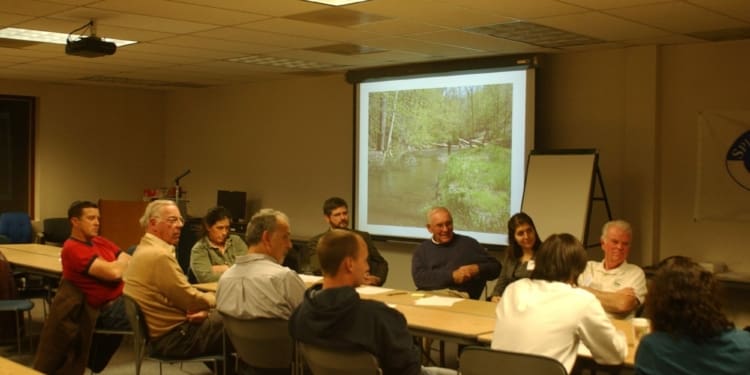Houses were destroyed, roads were washed out and lives were lost when Tropical Storm Irene barreled through upstate New York. As hard as it is to believe, it will happen again and may be worse the next time.
That was just one of the messages from members of the Onesquethaw-Coeymans Watershed Council, who sponsored a meeting Wednesday, Nov. 30, at the CSX Auditorium in Selkirk. The council examines issues along the Onesquethaw and Coeymans creeks and throughout the watershed, which runs through New Scotland, Bethlehem, Coeymans and Ravena. One of the goals of the meeting was to hear from area residents who felt the impacts of the once-in-a-lifetime flooding. David Coe of Glenmont attended the meeting on behalf of his sister and her husband, who live along Old Ravena Road in the Selkirk area and sustained damage to their more than 200-year-old home. “The water came up exactly to the first floor level,” said Coe. “They were extremely lucky it didn’t come in any higher than that, just a little bit of leakage inside the house. It totally flooded out the basement. There were trees in the basement, and it blew out some windows.” Coe said once the Coeymans Creek filled up, the water changed course in a matter of a “couple of minutes” and took aim at his sister’s home. He explained what it’s taken for the family to get the house back in order. “It took about two months of volunteer effort with family and friends to put that back together again, just in time for winter,” said Coe. “They moved most of their equipment and cars up to high ground, so that was ok.” New Scotland Supervisor Thomas Dolin attended the meeting as a town official and also a citizen “interested in the preservation and restoration of the creek.” Dolin said damages from the storm could approach $1.5 million just for New Scotland. “One of the interesting questions is what will it take financially to do some kind of mitigation,” said Dolin. “I’m here to learn a little bit about the future of the creek and the restoration of it.” Many, including Dolin, were concerned that flooding and damage could be even worse during significant storms in the future. “If this is going to be a reoccurring event every few years, the town is going to have to do some kind of planning in terms of prevention and protecting, maybe with different kinds of bridge and road designs,” said Dolin. Sander Bonvell, a volunteer with the council, said he heard information and suggestions from the roughly two dozen people in attendance. However, Bonvell said he did not hear as many stories as he had hoped. “The bottom line is, will people volunteer to do something or are they going to be in denial and wait until something happens, and see if they can get the town to come back or FEMA?” said Bonvell. After meeting in two smaller groups, those in attendance came together and talked about ideas such as working with other volunteer organizations to help clean up the creeks and creating phone trees in case of emergencies like Tropical Storm Irene. Bonvell said the problem is that there isn’t a large enough group of people involved. “If you’re going to get 20 people on a phone tree, you really need a much larger group to choose from. It’s a little more involved than just having a phone tree for a soccer game for the kids. You have to be there, because people could die.” For more information about the Onesquethaw Coeymans Watershed Council, visit www.ocwatershed.org.
Preventing a repeat of Irene
Leave Comment



